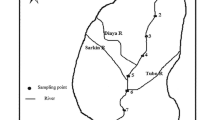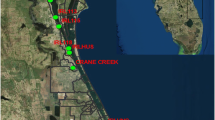Abstract
Principal Component Analysis (PCA) was used to derive estuarine salinity zones based on field data on the salinity ranges of 316 species/life stages in the mid-Atlantic region (chiefly Chesapeake Bay and Delaware Bay species). Application of PCA to the data matrix showed that the structure underlying a diversity of salinity distributions could be represented by only five Principal Components corresponding to five overlapping salinity zones: freshwater to 4‰, 2–14‰, 11–18‰, 16–27‰ to marine. The derived salinity zonation showed both differences and similarities to the Venice System of estuarine zonation. However, unlike the static and essentially descriptive Venice System, the new method will allow researchers to establish biologically-relevant local salinity zones, and then develop hypotheses about the processes that give rise to the resulting patterns. Examples of this procedure are given for the mid-Atlantic region. The method used here may also be useful for studying distributions across other environmental gradients, such as temperature, pH, substrate, turbidity, vegetation, or latitude.
Similar content being viewed by others
Literature Cited
Anonymous. 1959. Symposium on the classification of brackish waters. Venice 8–14th April 1958.Archivio di Oceanografia e Limnologia Volume 11. Supplemento (Simposio sulla Classificazione della Acque Salmastre. Venezia 8–14 Aprile, 1958).
Austin, M. T. 1972. Models and analysis of descriptive vegetation data, p. 61–86.In J. N. R. Jeffers (ed.), Mathematical Models in Ecology. Blackwell Scientific Publications, Oxford.
Briggs, J. C. 1974. Marine Zoogeography. McGraw-Hill, New York. 475 p.
Bulger, A. J., B. P. Hayden, M. E. Monaco, D. M. Nelson, andM. G. McCormick-Ray. 1990. A proposed estuarine classification: Analysis of species salinity ranges. ELMR Report No. 5, Strategic Assessment Branch, National Ocean Survey/National Oceanic and Atmospheric Administration, Rockville, Maryland. 28 p.
Chesapeake Bay Living Resources Task Force. 1987. Habitat Requirements for Chesapeake Bay Living Resources: A Report from the Chesapeake Bay Living Resources Task Force. Annapolis, Maryland. 108 p.
Comrey, A. L. 1973. A First Course in Factor Analysis. Academic Press, New York. 316 p.
Cronin, L. E. andA. J. Mansueti. 1971. The biology of the estuary, p. 14–39.In P. A. Douglas and R. H. Stroud (eds.), A Symposium on the Biological Significance of Estuaries. Sport Fishing Institute. Washington, D.C.
de Sylva, D. P., F. A. Kalber, andC. N. Schuster. 1962. Fishes and ecological conditions in the shore zone of the Delaware River estuary, with notes on other species collected in deeper water. University of Delaware Marine Laboratories Information Series, Publication No. 5. University of Delaware, Newark, Delaware. 164 p.
Foell, E. J. andJ. A. Musick. 1979. Community structure analysis and food habits of fishes, Section II. Virginia Institute of Marine Science, Special Reports in Applied Marine Science and Ocean Engineering No. 197. Virginia Institute of Marine Science, College of William and Mary, Gloucester Point, Virginia. 9-1–9-159.
Gosner, K. L. 1979. A field guide to the Atlantic Seashore (From Bay of Fundy to Cape Hatteras). Houghton Mifflin Co., Boston. 329 p.
Gower, J. C. 1966. Some distance properties of latent root and vector methods used in multivariate analysis.Biometrika 53:325–338.
Kendall, D. G. 1971. Seriation from abundance matrices, p. 215–242.In R. F. Hodson, D. G. Kendall, and P. Tautu (eds.), Mathematics in the Archeological and Historical Sciences. Edinburgh University Press, Edinburgh.
Kendall, D. G. 1975. Review lecture: The recovery of structure from fragmentary information.Philosophical Transactions of the Royal Society, A. 279:547–582.
Lippson, A. J. (ed.). 1973. The Chesapeake Bay in Maryland— An Atlas of Natural Resources. Johns Hopkins University Press, Baltimore, Maryland. 55 p.
Monaco, M. E., R. L. Emmett, D. M. Nelson, andS. A. Hinton. 1990. Distribution and abundance of fishes and invertebrates in west coast estuaries, Volume I: Data summaries. ELMR Report No. 4. Strategic Assessment Branch, National Ocean Survey/National Oceanic and Atmospheric Administration, Rockville, Maryland. 240 p.
Moyle, P. B. andJ. J. Cech. 1982. Fishes: An Introduction to Ichthyology. Prentice-Hall, Englewood Cliffs, New Jersey. 593 p.
Musick, J. A. 1972. Fishes of Chesapeake Bay and the adjacent coastal plain.In M. L. Wass (ed.), A Checklist of the Biota of Lower Chesapeake Bar With Inclusions From the Upper Bay and the Virginian Sea. Special scientific report no. 65. Virginia Institute of Marine Science, College of William and Mary, Gloucester Point, Virginia.
National Oceanic and Atmospheric Administration. 1985. National Estuarine Inventory: Data Atlas. Volume I. Physical and Hydrologic Characteristics. Strategic Assessment Branch, National Ocean Survey/National Oceanic and Atmospheric Administration, Rockville, Maryland. 135 p.
Overland, J. E. andR. W. Preisendorfer. 1982. A significance test for Principal Components applied to a cyclone climatology.Monthly Weather Review 110:1–4.
Remane, A. 1934. Die Brack wasserfauna.Verhandlungen der Deutschen Zoologischen Gesellschaft 36:34–74.
Kemane, A. andC. Schlieper. 1971. Biology of Brackish Water. John Wiley and Sons, Inc., New York. 372 p.
Schmidt-Nielsen, K. 1983. Animal Physiology: Adaptation and Environment. Cambridge University Press, Cambridge. 619 p.
Segerstråle, S. G. 1959. Brackish water classification, a historical survey.In Symposium on the Classification of Brackish Waters. Venice 8–14th April 1958.Archivio di Oceanografia e Limnologia Volume 11, Supplemento (Simposio sulla Classificazione della Acque Salmastre. Venezia 8–14 Aprile, 1958).
Stewart, L. L. and P. J. Auster. 1987. Species profiles: Life histories and environmental requirements of coastal fishes and invertebrates (North Atlantic)—Atlantic Tomcod. United States Fish and Wildlife Service, Biological Report No. 82 (11.76). United States Army Corps of Engineers, TR El-82-4. 8 p.
Swann, J. M. A. 1970. An examination of some ordination problems by use of simulated vegetational data.Ecology 51: 89–102.
Tabachnik, B. G. andL. S. Fidell. 1989. Using Multivariate Statistics. Harper and Row, New York. 746 p.
United States Fish and Wildlife Service. 1978. Development of Fishes of the Mid-Atlantic Bight. Biological Services Program, Fish and Wildlife Service, United States Department of the Interior. FWS/OBS-78/12. Vols. 1–6.
Wass, M. L. (ed.). 1972. A Checklist of the Biota of Lower Chesapeake Bay With Inclusions From the Upper Bay and the Virginian Sea. Special scientific report no. 65. Virginia Institute of Marine Science, College of William and Mary, Gloucester Point, Virginia. 290 p.
Wilkinson, L. 1987. Systat: The System for Statistics. Systat, Inc., Evanston, Illinois.
Williamson, M. H. 1978. The ordination of incidence data.Journal of Ecology 66:911–920.
Author information
Authors and Affiliations
Rights and permissions
About this article
Cite this article
Bulger, A.J., Hayden, B.P., Monaco, M.E. et al. Biologically-based estuarine salinity zones derived from a multivariate analysis. Estuaries 16, 311–322 (1993). https://doi.org/10.2307/1352504
Received:
Accepted:
Issue Date:
DOI: https://doi.org/10.2307/1352504




